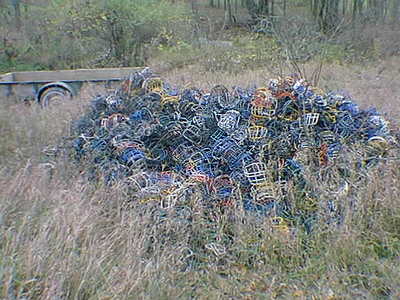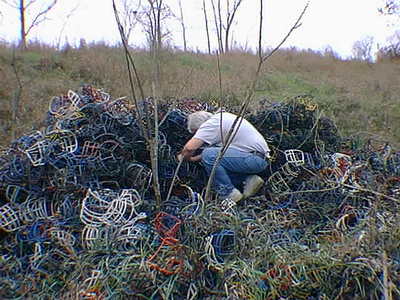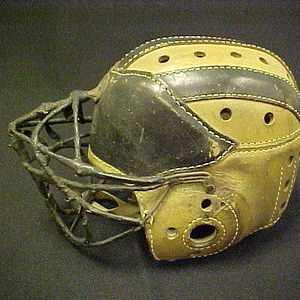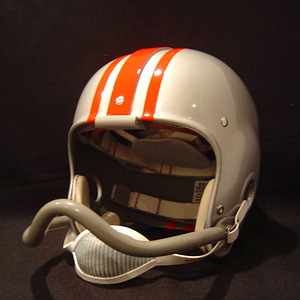

"The Rich History of Helmets"
The Rich History of Helmets
By Paul Lukas
ESPN Page 2
"Back in the old days, you could tell who a player was, or at least what
position he played, just by his facemask," says Curtis Worrell. "Today's masks
are so generic, the players basically look like robots, or interchangeable
parts."
Worrell knows what he's talking about. He and his business partner, Jim Parker,
run Helmet Hut, the football world's premier virtual helmet museum and
authorized helmet-reproduction firm. With enough detailed historical knowledge
to make Uni Watch look like a mere dilettante (plus a rather unique on-site
reference resource), they're experts on everything from players' mask
preferences to mask manufacturers. So Worrell seemed like the right guy to call
when Uni Watch decided to take a look at facemask history.
 |
 |
Worrell's point about the masks of yore is dead-on. Back in the day, the mere
mention of a player's name conjured up a mental image of his facemask, whether
it was Larry Csonka's nose guard, Joe Namath's cowcatcher, or Terry Bradshaw's
narrow two-bar (at least until he switched to that boring mask late in his
career). But can you name even one current player with a distinctive mask? No
wonder so many of them insist on dancing around like clowns on the field -- they
can't express their individuality through their facemasks anymore.
The party line, repeated in many sources, is that the first facemask was worn by
Otto Graham of the Cleveland Browns, who got elbowed in the mouth during the
first half of a 1953 game and then played the second half wearing a piece of
plastic that coach Paul Brown taped to his helmet.
It's a good story, but Worrell says the reality is a bit more complex. "Everyone
has their own opinion on who was first," he explains, "but we know for a fact
that it wasn't Otto Graham. Some of the improvised stuff probably goes back to
the 1920s. We've even got an old helmet with a mask made of barbed wire."
 |
Graham's true legacy, says Worrell, is that he wore the first mask that was
meant to be a mask. "After Paul Brown came up with that improvised mask, within
a few weeks Riddell (the longtime helmet manufacturer) made the very first
Lucite mask for him. That was the first mask that was designed to attach to a
helmet."
|
|
Although the clear Lucite masks looked really cool, they were brittle. "The
Lucite would shatter upon impact, and people would get cut or get the fragments
in their eyes," says Worrell. "So around 1957, they had to ban it."
Worrell and his Web site are loaded with facemask arcana, like the fact that
Chiefs teammates Otis Taylor and Fred Williamson both had two separate masks
bolted onto their helmets at once, or the exact catalog stock number of Ernie
Stautner's platypus-like mask. Here are Worrell's comments on some other notable
masked men:
John Henry Johnson: "That was the very first one-bar mask that Riddell produced.
It didn't stick out very far, so nowadays some people refer to it as the
'stubby.' One interesting thing is that when Joe Theismann was playing, he
wanted something like the stubby. But it wasn't being manufactured anymore, so
he took a modern one-bar and shoved it as far back as possible on his helmet, so
there'd be nothing to interfere with his vision."
Joe Perry: "People were complaining about broken noses with the one-bar, so they
tweaked it upward to give a bit more nose protection. Eddie LeBaron wore one of
these in conjunction with a one-bar, which looked kind of like a duck -- that's
one of my favorites!" (It's also worth noting that Perry had previously worn an
even odder mask, designed by Dr. M.T. Marietta, whose product line included some
real doozies.)
 |
Y.A. Tittle and Roosevelt Brown: "Both of those players had had broken facial
bones, so they needed extra protection. Also, the helmets back then were soft
and would bend in. So the idea of that metal bracketing was to absorb the impact
and keep it from caving in."
John Williams: "He used two Dungard facemasks. The upper one could actually flip
up, like sunglasses, but they usually taped it to the lower one."
But for some players, the best mask was no mask at all. It's generally agreed
that the final lineman to play without a mask was Jess Richardson of the
Patriots, who retired in 1964. The last maskless player at a skill position is a
matter of some dispute, but Worrell recently came up with this photo of wide
receiver Tommy McDonald playing unmasked for the Browns in 1968, which would
appear to end the debate.
|
|
Or does it? Pat Studstill wore a facemask while playing flanker but switched to
a maskless helmet when punting, placing him in a sort of gray area. "He was
doing that for the Rams as late as 1971," says Worrell. And Bobby Joe Green of
the Bears might have been doing likewise as late as 1974.
Worrell has little use for today's characterless facemasks (including the
odd-looking ones found on the new Riddell Revolution helmets, which he says are
known in the trade as "field hockey masks"). But he has a special place in his
heart for veteran placekicker Morten Andersen, who's kept wearing his
old-fashioned Dungard two-bar while playing with the Saints, the Falcons, the
Giants , the Chiefs, and now the Vikings.
"That's my boy," says Worrell. "He's a real throwback and he's not gonna change.
And you know, that mask is directly bolted on at the top [instead of being held
by clips], which isn't even legal today, because there's no give. He can only
wear it because he's grandfathered in."
|
|
Worrell also doesn't much care for today's color-coordinated facemasks. "Just
gimme basic gray," he says. (He no doubt loves that Titans kicker Gary Anderson
wears a gray one-bar, even though the rest of the team wears navy.) Ah, but then
we wouldn't have great little stories like the 1974 Chiefs, who switched from
gray masks to white because their equipment manager figured the contrast of an
opponent's hand against a white mask would make it easier for officials to spot
facemask penalties.
It's a good thing the Helmet Hut folks are around to document all this minutiae,
because the NFL and the Pro Football Hall of Fame are surprisingly spotty on the
uni-related aspects of gridiron history. But as Worrell points out, the NFL
wasn't always the high-profile operation it is today.
"Remember, for decades this was a league that had no money," he says. "I mean,
they were paying their players in the parking lot after the game. They just
couldn't be bothered with archiving all this stuff." Fortunately, he's done it
for them.